GitOps with ArgoCD
ArgoCD with Jenkins CI Pipeline
CICD Pipeline Demo
In this tutorial, we demonstrate how a CI/CD pipeline can leverage GitOps principles using ArgoCD through a practical example. The demo follows a streamlined four-step process:
- A developer clones the Solr system repository, makes modifications, and pushes them to a feature branch.
- A Jenkins job builds the application using a Jenkinsfile.
- A pull request is created in the Kubernetes manifest repository; once reviewed, it’s merged.
- The ArgoCD application detects the changes, synchronizes the new configuration, and performs a rollback if needed.
Each stage is detailed below, complete with diagrams and code examples.
Step 1: Developer Workflow & Repository Update
The process begins with the developer cloning the Solr system repository, making the necessary updates, and pushing them. The diagram below illustrates the overall software development and deployment process:
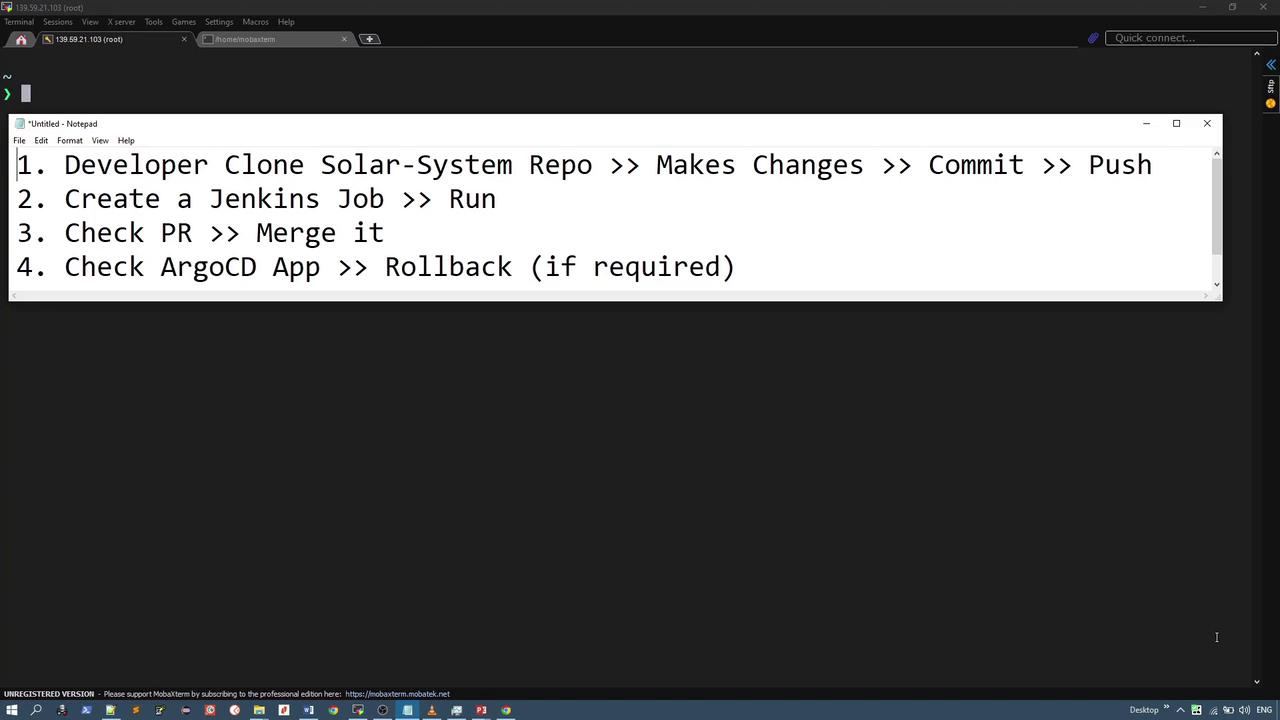
Developer Task Overview
A user story requires replacing a static solar system image with an animated version. The repository includes key files like Dockerfile, Jenkinsfile, index.php, and images.
First, the developer inspects a local directory that contains the new image files:
ll changes
total 700
drwxr-xr-x 2 root root 4096 Sep 25 19:39 ./
drwx----- 13 root root 4096 Sep 25 19:39 ./
-rw-r--r-- 1 root root 339116 Sep 25 13:55 animated-solar-system.png
-rw-r--r-- 1 root root 364624 Sep 25 13:22 bg.gif
Since the application is a simple PHP app, the console is used to execute file operations. The repository is cloned as follows:
git clone http://139.59.21.103:3000/siddharth/solar-system
After changing into the repository directory, the structure is:
total 32
drwxr-xr-x 4 root root 4096 Sep 25 19:44 ./
drwxr-xr-x 3 root root 4096 Sep 25 19:44 ../
drwxr-xr-x 4 root root 4096 Sep 25 19:44 .git/
-rw-r--r-- 1 root root 274 Sep 25 19:44 Dockerfile
-rw-r--r-- 1 root root 515 Sep 25 19:44 Jenkinsfile
drwxr-xr-x 2 root root 4096 Sep 25 19:44 images/
-rw-r--r-- 1 root root 483 Sep 25 19:44 index.php
-rw-r--r-- 1 root root 517 Sep 25 19:44 pr.sh
The developer then copies the new images into the images directory:
cp /root/changes/animated-solar-system.png images/
cp /root/changes/bg.gif images/
After copying, listing the images directory confirms the transfer:
l images/
total 2584
drwxr-xr-x 5 root root 4096 Sep 25 19:45 ./
drwxr-xr-x 1 root root 4096 Sep 25 19:44 ../
-rw-r--r-- 1 root root 339116 Sep 25 19:44 animated-solar-system.png
-rw-r--r-- 1 root root 7347895 Sep 25 19:44 background.png
-rw-r--r-- 1 root root 364642 Sep 25 19:44 bg.gif
...
Next, the index.php file is updated to reference the new animated image and background GIF:
<?php
echo "<!DOCTYPE html>
<html>
<head>
<meta name='viewport' content='width=device-width, initial-scale=1'>
<style>
#solar-system {
background: url('http://139.59.21.103:3000/siddharth/solar-system/raw/branch/main/images/animated-solar-system.png') center;
background-repeat: no-repeat;
background-size: cover;
content: '';
position: static;
animation: spin 25s linear infinite;
width: 50vw;
height: 50vw;
}
@keyframes spin {
100% { transform: rotate(360deg); }
}
body {
display: flex;
align-items: center;
justify-content: center;
background: url('http://139.59.21.103:3000/siddharth/solar-system/raw/branch/main/images/bg.gif');
}
/*
.shadow {
animation: rainbow 2s linear infinite;
}
*/
</style>
</head>
</html>";
?>
Before committing, the developer checks the repository status:
git status
The status indicates modifications to index.php and shows the two untracked images. The changes are then committed:
git commit -m "Added two new images for solar-system and background"
Finally, the commit is pushed to the repository's feature branch. The following snapshot shows the repository interface after the push:
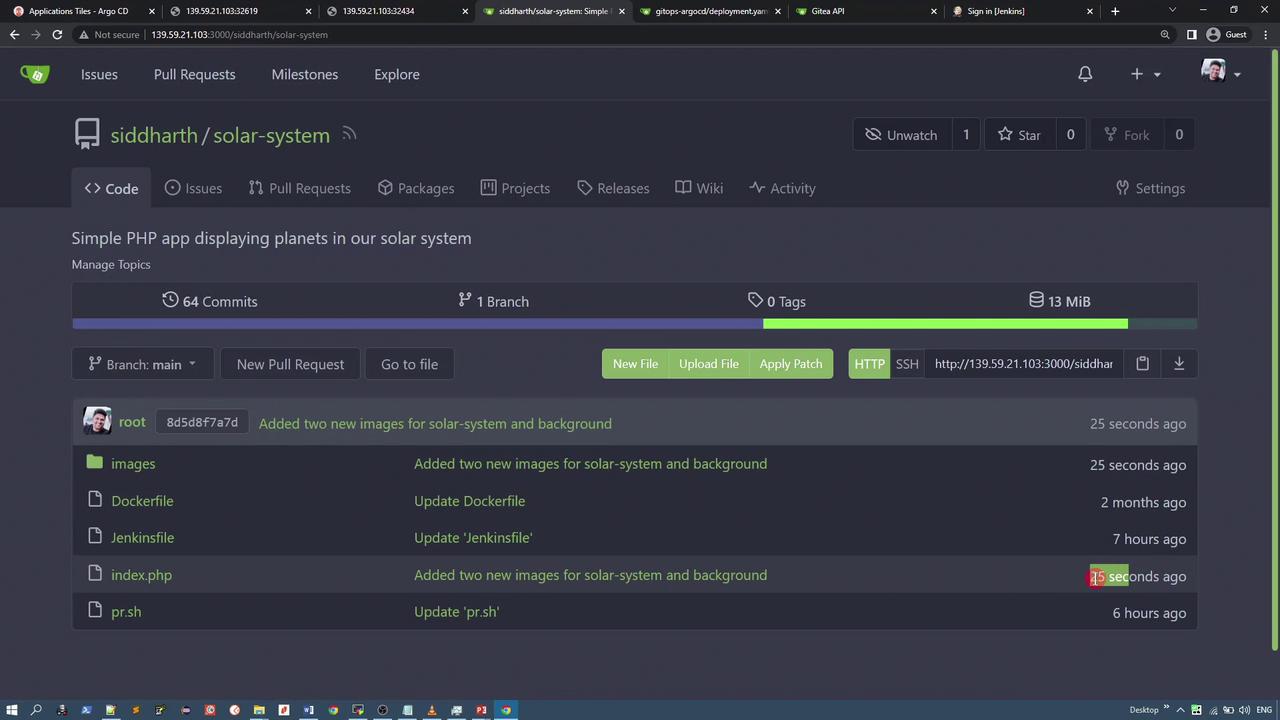
Tip
Ensure all image paths in your HTML or CSS are updated correctly to reflect new file locations.
Step 2: Jenkins Job Setup and Build Process
With the updated code in the repository, the next step is setting up the Jenkins job. A new pipeline project called "solar system dynamic demo" is created with the following configuration:
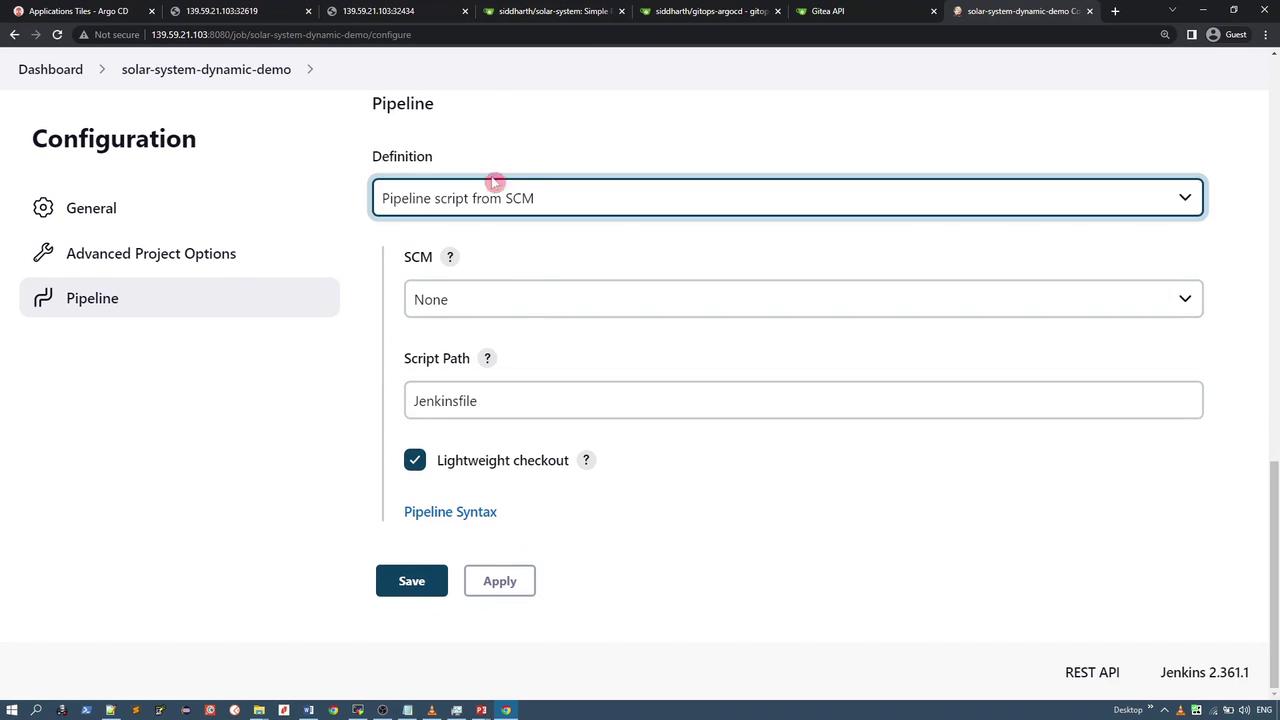
Build Process Details
During the Jenkins build, multiple stages are executed. Here’s an overview:
Unit Tests: These may be simple echo commands or actual test cases if using frameworks such as Spring Boot, Node.js, or Python.
Build Stage: A Docker image is created using the repository's
Dockerfile. An example output is:docker build -t solar-system . Sending build context to Docker daemon 20.82MB Step 1/4 : FROM php:7.4-apache ---> 591eebf57822 Step 2/4 : COPY index.php /var/www/html/ ---> 83a9d0024550 Step 3/4 : COPY images /var/www/html/images ---> e47a507ab999 Step 4/4 : EXPOSE 80 ---> 0d39eba8eff2 Successfully built 0d39eba8eff2 Successfully tagged solar-system:latestImage Tagging: The newly built image is tagged to include the build ID and commit details:
docker tag solar-system:latest siddharth67/solar-system:1-f42550fcabef2842074ee16fa005fec3e4d5e8e4Push Stage: The image is pushed to Docker Hub with layered progress shown in the logs.
GitOps Update: Jenkins then clones the GitOps ArgoCD repository. On the first run, it performs a clone; on subsequent runs, it uses a pull:
git clone -b feature-gitea http://139.59.21.103:3000/siddharth/gitops-argocdOnce the manifest is cloned, the deployment file is updated to reference the new image:
sed -i "s#siddharth67/#${IMAGE_REPO}/${NAME}:${VERSION}#g" deployment.yaml cat deployment.yamlCommitting and Pushing Manifest Changes:
The Git configuration is updated and changes are committed and pushed as follows:git config --global user.email '[email protected]' git remote set-url origin http://[email protected]:3000/siddharth/gitops-argocd git checkout feature-gitea git add -A git commit -am "Updated image version for Build - $VERSION" git push origin feature-giteaPull Request Creation:
A shell script (pr.sh) utilizes curl to raise a pull request automatically:bash pr.shThe output confirms that the pull request has been successfully created:
Opening a Pull Request % Total % Received % Xferd Average Speed Time Time Current ... {"id":13,"url":"http://139.59.21.103:3000/siddharth/gitops-argocd/pulls/10", ... }
A snapshot of the Git repository interface depicting commits, branches, and files is shown below:
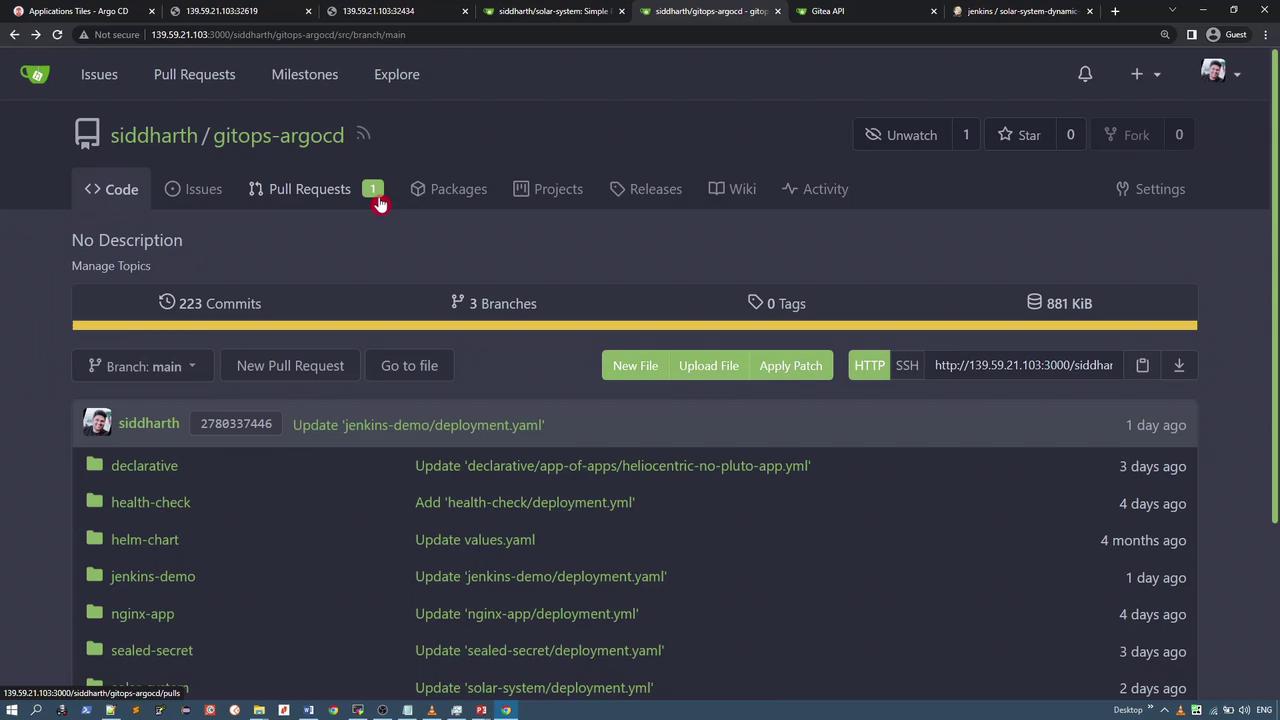
Step 3: ArgoCD Application Sync and Deployment
Once the pull request is merged, the ArgoCD application synchronizes the changes. Two applications are used:
- One monitors the feature branch.
- The other monitors the production (main) branch.
They are deployed to separate namespaces and exposed via NodePort. The following dashboard shows their status:
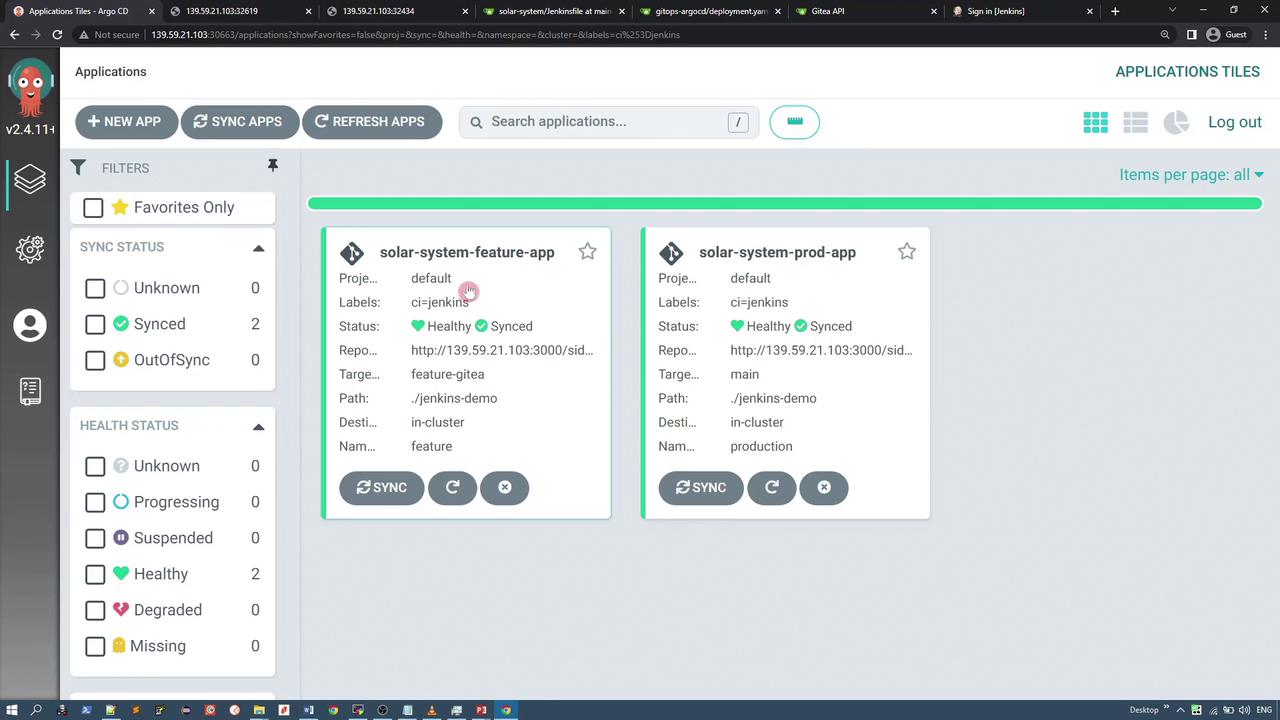
After synchronizing the feature app, changes like the animated background and updated solar system view are visible. The Jenkins pipeline logs also display an updated deployment.yaml file, similar to:
apiVersion: apps/v1
kind: Deployment
metadata:
labels:
app: solar-system
name: solar-system
spec:
replicas: 1
selector:
matchLabels:
app: solar-system
strategy: {}
template:
metadata:
labels:
app: solar-system
spec:
containers:
- image: siddharth67/solar-system:1-f425250fcabf2842074ee16fa805fec3e4d58e4
name: solar-system
ports:
- containerPort: 80
Following the merge into the main branch, the production ArgoCD application initially becomes out of sync. Synchronizing it updates the deployment accordingly. Below is a snapshot of the deployment management dashboard:
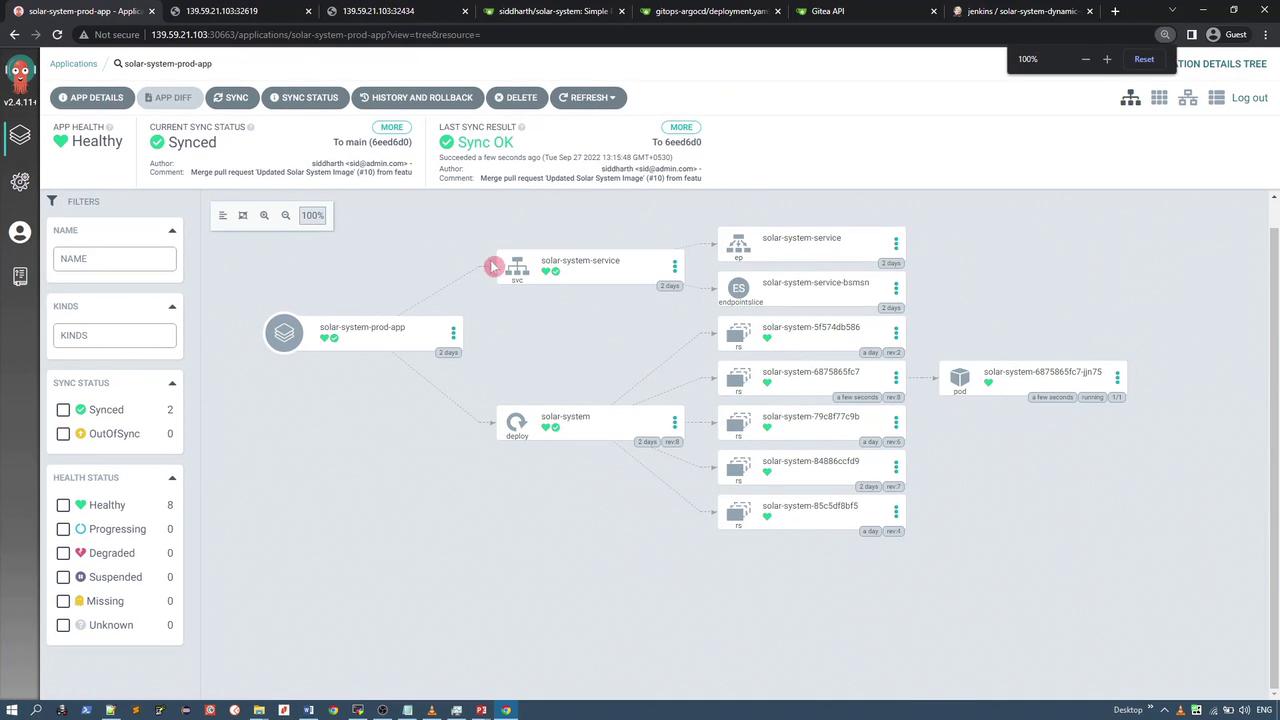
Step 4: Rollback (If Required)
Post-deployment, user feedback indicated that the flashy animated background was not ideal. Using the ArgoCD UI, an administrator can perform a rollback to a previously stable version by selecting the desired version from the application's history and clicking the rollback option.
Important
Always validate the UI changes after a rollback to ensure the production system remains stable.
Once confirmed, the production UI reverts to displaying the previously stable version of the solar system, ensuring users see the version they preferred.
Conclusion
This walkthrough illustrated how CI/CD pipelines integrate GitOps with ArgoCD to automate the entire release process – from code modification and Jenkins-driven builds to deployment updates and rollbacks. By leveraging tools like Jenkins for build automation and ArgoCD for deployment management, teams can ensure rapid, reliable, and reversible releases.
For more insights into CI/CD and GitOps, check out the following resources:
Thank you for following along with this detailed demonstration.
Watch Video
Watch video content